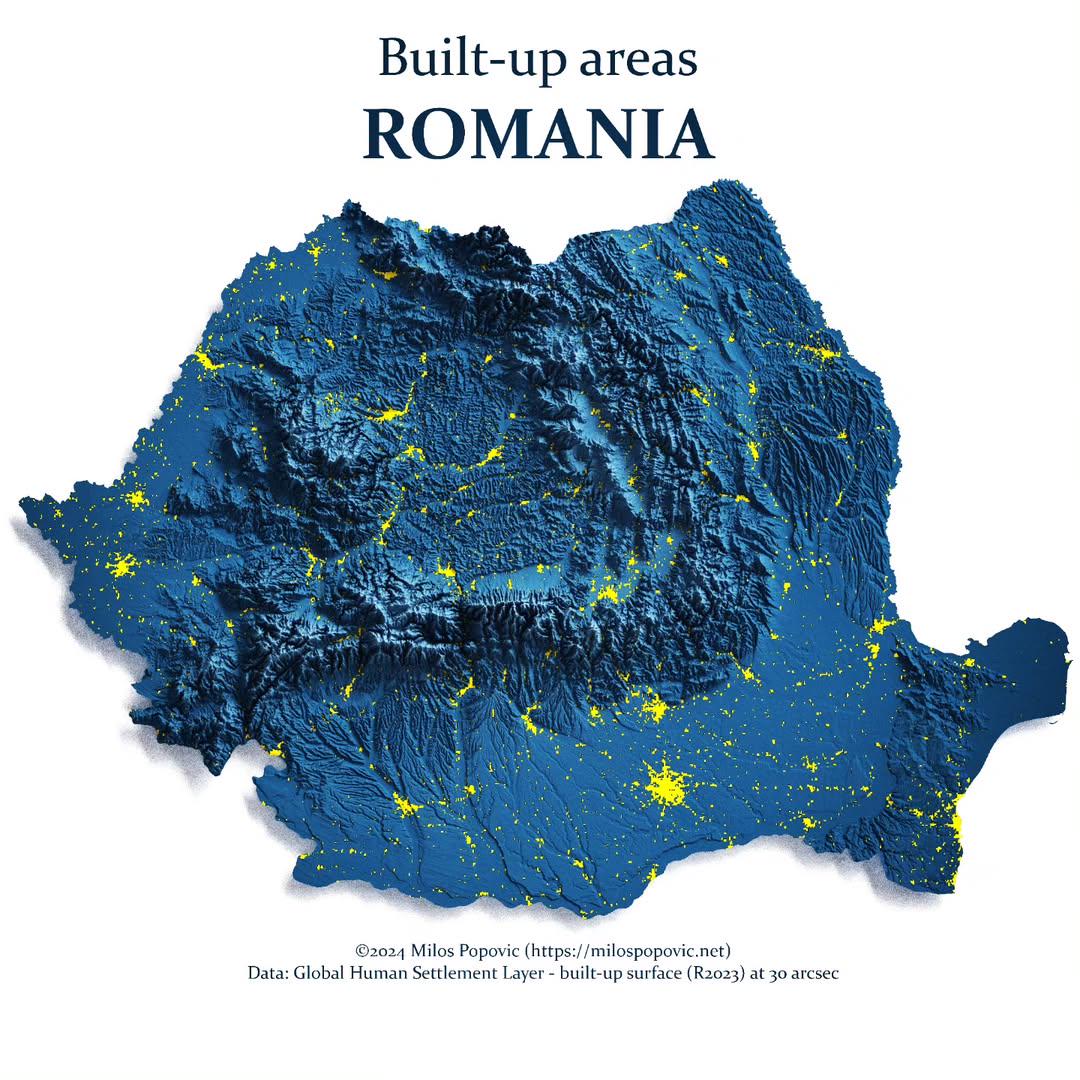Built-up Areas in Romania Map


David Chen
Data Visualization Specialist
David Chen is an expert in transforming complex geographic datasets into compelling visual narratives. He combines his background in computer science ...
Geographic Analysis
What This Map Shows
The "Built-up Areas in Romania" map provides a clear visualization of urbanized regions across the country. By illustrating where development has occurred, it allows viewers to see the concentration of buildings, infrastructure, and overall human settlement. This map plays an essential role in understanding the spatial distribution of urban environments in Romania, highlighting the areas where urbanization is most pronounced.
Deep Dive into Built-up Areas in Romania
Romania's urban landscape is shaped by a complex interplay of historical, geographical, and socio-economic factors. The built-up areas, which encompass cities and towns, demonstrate the evolution of human settlement patterns from ancient times to the present day.
Interestingly, Romania has a mix of large urban centers and smaller towns, each contributing uniquely to the overall built environment. The major cities, such as Bucharest, Cluj-Napoca, and Timișoara, are characterized by dense populations and significant economic activity. Bucharest, the capital, is the most populous city, home to around 2 million residents. It serves as the political, economic, and cultural heart of the country, showcasing a blend of historical architecture and modern developments.
However, it's not just the capital that tells the story of urban growth. Cluj-Napoca, often referred to as the unofficial capital of Transylvania, has seen rapid development in recent years, fueled by a booming technology sector and a vibrant student population. This city embodies the shift towards innovation and modernity, attracting both local and international investment.
In contrast, smaller towns and rural areas, while less densely built-up, play a vital role in Romania’s demographic landscape. Places like Sighișoara and Sibiu, known for their historical significance and well-preserved architecture, highlight the importance of heritage tourism. These towns, while not as built-up as larger cities, attract visitors and preserve cultural identity.
The variation in built-up areas across Romania is influenced by several factors, including geography, access to resources, and economic opportunities. Urbanization trends show that many Romanians are moving towards cities in search of employment, leading to increased pressure on infrastructure and housing in these areas. Moreover, the growth of suburban areas around major cities reflects a changing lifestyle, where people seek the benefits of urban living while enjoying the tranquility of suburban life.
Regional Analysis
When examining the built-up areas across different regions of Romania, notable differences emerge. For instance, the Transylvanian region is known for its picturesque towns and historical significance, while the southern region, particularly around Bucharest, showcases a more modern, industrialized landscape.
In Transylvania, cities like Brașov and Târgu Mureș exemplify how historical context shapes urban development. Brașov, surrounded by the Carpathian Mountains, retains its medieval charm, attracting tourists year-round. In contrast, the Bucharest metropolitan area has experienced urban sprawl, with new developments pushing into previously rural zones. This expansion has resulted in a mix of old and new, where traditional Romanian architecture coexists with contemporary designs.
Interestingly, the western part of Romania, particularly in regions like Banat, reflects a different pattern of urbanization. Cities like Timișoara, with its rich cultural heritage and diverse population, have become economic hubs, influencing migration patterns from surrounding rural areas. The map indicates a significant concentration of built-up areas in this region, showcasing the impact of economic development on urbanization.
Significance and Impact
Understanding the distribution of built-up areas in Romania is crucial for policymakers, urban planners, and environmentalists alike. As urbanization continues to reshape the landscape, it raises important questions about sustainability, resource management, and the quality of life for residents.
Current trends suggest that Romania’s urban centers will continue to grow, driven by economic opportunities and migration from rural areas. However, this growth must be managed carefully to mitigate challenges such as traffic congestion, pollution, and the loss of green spaces.
Interestingly, Romania's urbanization story is not just about expansion; it's also about revitalization. Many cities are investing in sustainable development initiatives, aiming to improve living conditions while preserving their cultural heritage. The built-up areas map serves as a tool to visualize these changes and guide future urban planning efforts, ensuring that development aligns with the needs of the population while respecting the environment.
In conclusion, the built-up areas in Romania reflect a dynamic landscape shaped by historical, cultural, and economic factors. As we look towards the future, understanding these patterns will be vital for fostering sustainable growth and enhancing the quality of life for all Romanians.
Visualization Details
- Published
- October 20, 2025
- Views
- 40
Comments
Loading comments...